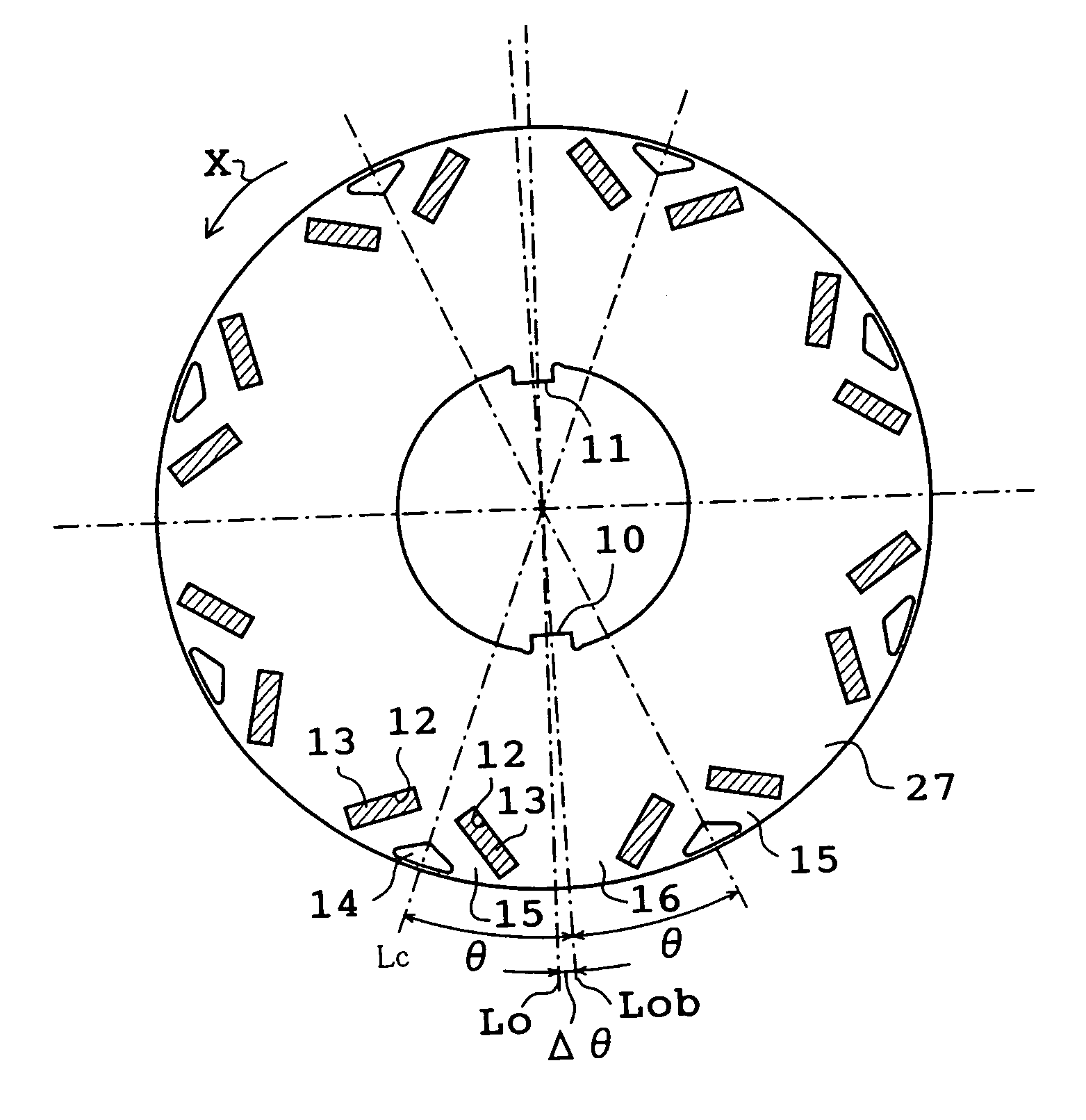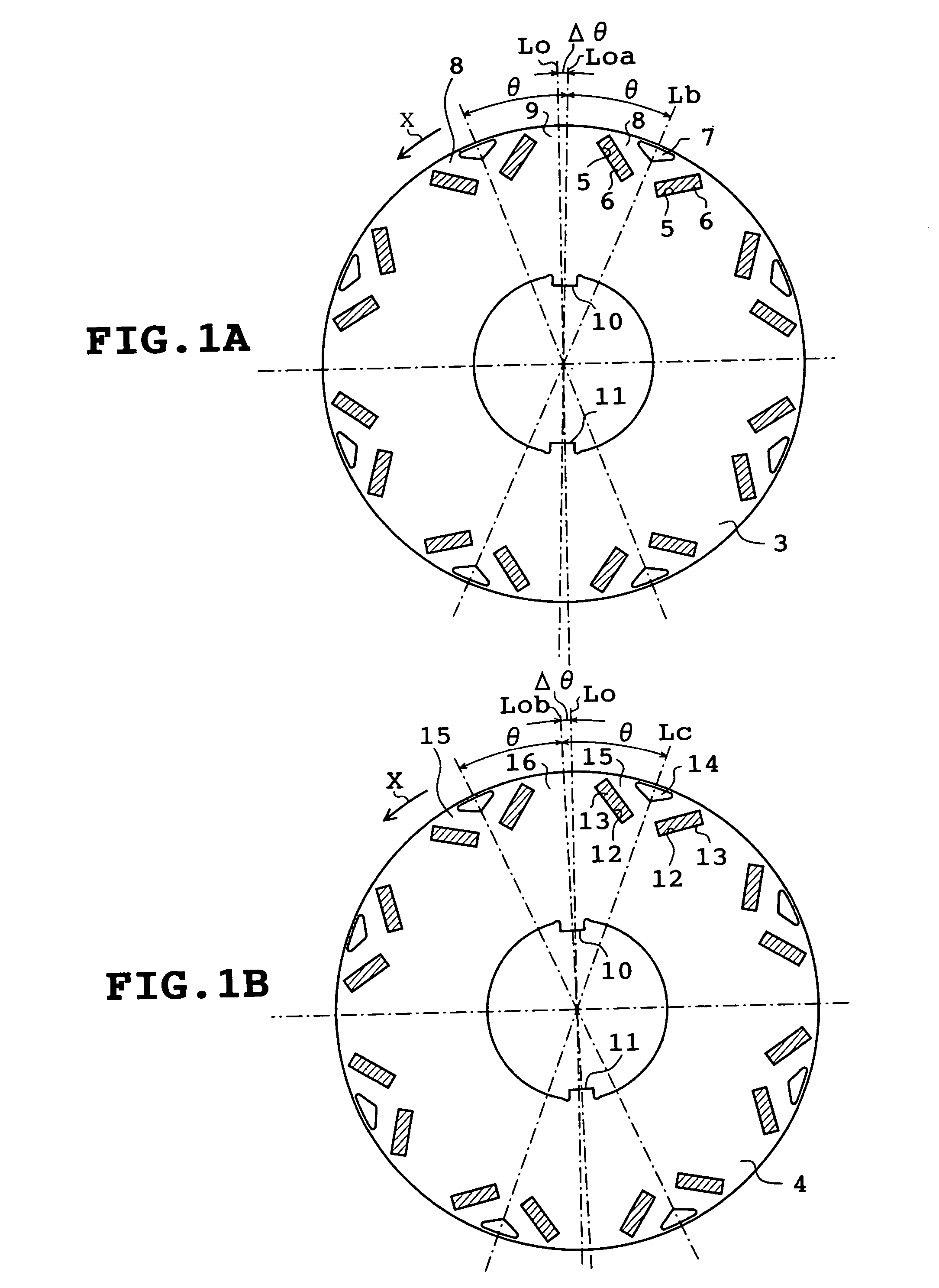Rotor for reluctance type rotating machine
a technology of electric rotating machines and rotors, which is applied in the direction of magnetic circuit rotating parts, synchronous motors, magnetic circuit shapes/forms/construction, etc., can solve the problems of vibration noise, vibration ripple, oscillation, etc., and achieve the effect of reducing the harmonic value of the counter electromotive for
- Summary
- Abstract
- Description
- Claims
- Application Information
AI Technical Summary
Benefits of technology
Problems solved by technology
Method used
Image
Examples
first embodiment
[0031]Several embodiments of the present invention will be described. FIGS. 1A to 5 illustrate a first embodiment in which the invention is applied to a reluctance type rotating machine with permanent magnets. The reluctance type rotating machine possesses eight poles. A rotor 1 of the reluctance type rotating machine includes a rotor core 2 made by stacking a number of annular silicon steel sheets serving as a core material. The rotor core 2 is divided into four blocks 3 and 4 having the same thickness as shown in FIG. 2. The blocks 3 and 4 are stacked alternately.
[0032]Each block 3 or the silicon steel sheets composing each block 3 will be described with reference to FIG. 1A. Each block 3 has a number of pairs of generally rectangular magnet insertion holes 5 formed in an outer circumferential portion thereof. The paired magnet insertion holes 5 are opposed to each other so that a distance therebetween is gradually rendered longer as the magnet insertion holes 5 approach an outer ...
second embodiment
[0046]The annular silicon steel sheets constituting the rotor core 26 are formed by punching a rolled elongated silicon steel sheet. It is well known that the rolling results in shift in the thickness in the rolling direction and in the direction perpendicular to the rolling direction. In the second embodiment, however, the blocks 27 obtained by turning the blocks 4 circumferentially by 180 degrees. Consequently, since the deviation in the thickness is absorbed, the thickness of the rotor core 26 can be rendered uniform.
[0047]The thicknesses of the four blocks 3 and 27 are equal to one another in the second embodiment. However, the total thickness of the blocks having the respective center lines Lb may be equal to the total thickness of the blocks having the respective center lines Lc.
[0048]FIGS. 9 to 11 illustrate a third embodiment of the invention. Describing the difference of the third embodiment from the first embodiment, the rotor core 28 employed instead of the rotor core 2 i...
fifth embodiment
[0056]The portions 43a and 43b and the portions 44a and 44b constituting the respective blocks 43 and 44 are set at one halves of the thicknesses of the blocks 43 and 44 respectively in the However, these portions may be set substantially at one halves respectively.
[0057]The permanent magnets are provided on the rotor core in each of the foregoing embodiments. However, the permanent magnets may or may not be provided on the rotor core. Further, the generally triangular cavities are formed in the rotor core so as to compose the concave and convex portions in each of the foregoing embodiments. However, the cavities may be circular, elliptic, rectangular or rhombic. Additionally, the rotor core may have mechanical concave and convex portions formed therein so that the magnetic concave and convex portions are formed.
[0058]The number of poles of the rotor should not be limited to eight. The same effect can be achieved even when the number of poles is any other number. Furthermore, the n...
PUM
| Property | Measurement | Unit |
|---|---|---|
| angle | aaaaa | aaaaa |
| magnetic | aaaaa | aaaaa |
| distance | aaaaa | aaaaa |
Abstract
Description
Claims
Application Information
 Login to View More
Login to View More - R&D
- Intellectual Property
- Life Sciences
- Materials
- Tech Scout
- Unparalleled Data Quality
- Higher Quality Content
- 60% Fewer Hallucinations
Browse by: Latest US Patents, China's latest patents, Technical Efficacy Thesaurus, Application Domain, Technology Topic, Popular Technical Reports.
© 2025 PatSnap. All rights reserved.Legal|Privacy policy|Modern Slavery Act Transparency Statement|Sitemap|About US| Contact US: help@patsnap.com



